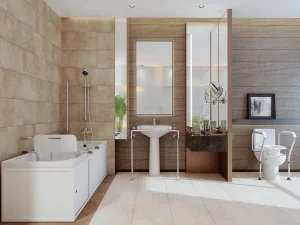Water-Efficient Bathroom Fixtures and Conservation Techniques: A Smarter Way to Save
5 min read
Let’s be honest. Most of us don’t think much about our bathroom water use until the utility bill arrives. That sudden gulp you hear? It’s not the toilet—it’s you, seeing the cost of all those long, hot showers and the constant running of the tap. But what if your bathroom could work smarter, not harder?
Transforming your bathroom into a water-saving haven isn’t about sacrifice. It’s about efficiency. It’s about using clever technology and simple habits to get the same great results with a fraction of the water. And honestly, the impact is staggering. The EPA estimates that if just one in ten American homes upgraded to WaterSense-labeled fixtures, we could save a whopping 74 billion gallons of water annually. That’s a lot of liquid.
The Heavy Hitters: Upgrading Your Core Fixtures
Here’s the deal: the biggest water savings come from a few key players. Think of these as the foundation of your water-efficient bathroom.
Low-Flow Showerheads: Your Daily Water Saver
Old showerheads can use a deluge-like 5-8 gallons per minute (GPM). A modern, low-flow model uses 2.0 GPM or less. Do the math. For a 10-minute shower, that’s a saving of up to 60 gallons. Every. Single. Day.
And forget the old, wimpy drizzle. Today’s best water-saving showerheads use aeration or laminar flow technology. They mix air with water, creating a shower stream that feels just as full and invigorating. It’s like getting a luxury experience for a fraction of the cost and resource use.
High-Efficiency Toilets: Flushing Money Down the Drain?
Toilets are the single biggest water users inside your home. If yours was installed before 1994, it might be guzzling 3.5 to 7 gallons per flush. Yikes. Modern high-efficiency toilets (HETs) use just 1.28 gallons per flush (GPF) or less.
Dual-flush models take this a step further, offering a choice: a light flush for liquid waste and a full flush for solids. It’s a simple, intuitive way to save water without a second thought. Upgrading an old toilet can save a family of four nearly 20,000 gallons of water a year. That’s not just a drop in the bucket.
Faucet Aerators: The Unsung Hero
This is the easiest, cheapest upgrade you can possibly make. For just a few dollars, a faucet aerator screws onto the end of your spout. It mixes air into the water stream, reducing flow from 2.2 GPM to a more sensible 1.5 GPM or lower.
The result? You still get great water pressure for washing your hands or brushing your teeth, but you use significantly less water. It’s a no-brainer. Honestly, if you do one thing after reading this, install aerators on every bathroom sink.
Beyond the Basics: Smart Habits and Subtle Shifts
Okay, so fixtures do the heavy lifting. But your daily routine matters, too. These small, almost effortless changes compound into massive savings over time.
Shower Smarter, Not Longer
We all love a long, contemplative shower. But try shaving just two or three minutes off your time. Put on a short song and try to be done by the final chorus. You’ll save gallons with every shower. Another pro tip? Turn off the water while you’re lathering up with shampoo or soap. It feels a bit odd at first, but you quickly get used to it.
The Toothbrushing Trick
This is a classic for a reason. There is absolutely no need to let the tap run while you’re brushing. Wet your brush, turn it off, brush for two minutes, then turn it back on to rinse. A running faucet can waste up to 4 gallons of water in those two minutes alone. Multiply that by your household… you see where this is going.
Catch the Cold
You know how you wait for the shower water to get hot? Instead of letting that perfectly good cold water spiral down the drain, catch it in a bucket. Use it to water houseplants, pour it into the dog’s bowl, or even use it to flush the toilet. It’s a simple act of capturing what would otherwise be wasted.
Leaks: The Silent Water Thieves
A leaky faucet or a toilet that runs constantly is more than an annoyance. It’s a hemorrhage of water and money. A single dripping faucet can waste over 3,000 gallons a year. But a running toilet? That’s a real nightmare, potentially wasting up to 200 gallons of water… every day.
Here’s a quick way to check for a toilet leak. Put a few drops of food coloring in the tank. Wait 15-20 minutes without flushing. If you see color in the bowl, you have a silent leak that needs fixing, usually a simple flapper valve replacement.
Making the Choice: What to Look For
Feeling overwhelmed by options? Don’t be. Just look for the label.
The EPA’s WaterSense label is your best friend here. It’s like the ENERGY STAR program, but for water. Products with this label are certified to be at least 20% more efficient than average models without sacrificing performance. They are independently certified and a surefire way to know you’re making a smart choice.
| Fixture Type | Old/Standard Use | Water-Efficient Use | Potential Annual Savings* |
| Showerhead | 5.0 GPM | 2.0 GPM | 9,000+ gallons |
| Toilet | 3.5 GPF | 1.28 GPF | 13,000+ gallons |
| Bathroom Faucet | 2.2 GPM | 1.5 GPM | 2,000+ gallons |
A Ripple Effect
So, why does all this matter beyond your monthly bill? Every gallon of water we save is a gallon that doesn’t need to be treated and pumped, saving energy and reducing strain on our community’s infrastructure. In many parts of the world—and increasingly, in parts of our own country—fresh water is a precious, finite resource.
Creating a water-efficient bathroom isn’t a radical act. It’s a practical one. It’s a series of small, intelligent choices that add up. It’s about building a home that works in harmony with the planet’s resources, not against them. And it starts with a single, simple step. Which one will you take first?


















